Bay of Fundy and Southern Uplands watersheds priority place

Location
This place includes the watersheds that drain into the Bay of Fundy (Nova Scotia and New Brunswick) and those that make up the Southern Uplands ecoregion (Nova Scotia). Within this broader area, there are several key rivers in which multiple species at risk (SARA-listed and COSEWIC-assessed) are found.
Key threats
Modifications of natural systems (e.g., dams and other barriers to fish passage), water and habitat quality (e.g., riparian zone impacts, acidification, instream habitat deterioration, various land use practices and impacts), and invasive species are significant threats to freshwater species at risk in these watersheds.
Aquatic SARA Schedule 1-listed species at risk found in the Bay of Fundy and Southern Uplands watersheds priority place
| Priority Places and Marine Threats | Species, Population | SARA status |
|---|
Examples of recovery activities that DFO is seeking to support in the Bay of Fundy and Southern Uplands watersheds priority place
- Activities to support the establishment of self-sustaining populations of:
- Atlantic Whitefish: range expansion activities in support of conservation translocation in new locations and re-establishing anadromy by undertaking strategic releases into the Petite system (including but not limited to wild-juvenile collections; holding, raising and captive-breeding for the production of progeny to support strategic releases; use of streamside rearing trailer; genetic research and development of genomic tools for decision-making and monitoring; development and implementation of operational plans; and development and implementation of monitoring approaches), and aquatic invasive species control actions such as boat electrofishing, outreach/education, or other methods
- Atlantic Salmon, inner Bay of Fundy population: development of innovative methods to support population supplementation, such as streamside trailers, egg baskets, and marine net pens
- Identify and improve degraded freshwater, riparian, and estuarine habitat that are important to multiple species at risk and develop improved land use practices to prevent future habitat degradation. High quality projects will include the identification and mitigation of threats, and the development and implementation of restoration plans to guide the prioritization of restoration actions
- Identify and improve fish passage in key locations to mitigate connectivity issues for multiple species at risk, including undertaking activities to assess dams, aboiteaux and other barriers for their restoration potential, and restoring fish passage to mitigate threats posed by the structures, in consideration of risks (e.g., avoiding AIS passage) and benefits (e.g., promoting species at risk passage)
- Identify and implement measures to prevent and mitigate the threat of AIS, in particular Zebra mussels, Smallmouth Bass, Chain Pickerel, and Black Crappie, in key locations that are important to multiple species at risk
- Examine long-term changes in environmental conditions in the Bay of Fundy freshwater and estuarine environments. Compare these changes with past and present habitat use by species at risk and threats to identify changes in habitat use and possible mitigation measures to address threats. Information and data gaps for which further research necessary to support the recovery of species at risk is required include: climate change, cumulative threats, past and present chemical and physical habitat quality characteristics, predator prey relationships, prey composition, and species at risk abundance and distribution data
- Conduct broad-scale (i.e. multi-waterbody, multi-species) population assemblage (e.g. genetics), habitat (e.g. water quality), and/or movement and migration of individuals monitoring and assessments in freshwater waterbodies that have limited or no data to develop baselines, identify important habitat and anthropogenic threats, and implement actions to mitigate threats; using multiple and innovative methods for monitoring such as eDNA, electrofishing, piloting new monitoring methodologies and for tracking (such as PIT tag arrays, acoustic telemetry)
- Promote, support, and undertake stewardship and education activities to increase local awareness of regional species at risk and their threats and engage Indigenous Peoples, residents and landowners, recreational users, industry, non-governmental organizations, and others in stewardship activities that directly contribute to their recovery, including the collection, documentation and incorporation of Indigenous Knowledge into recovery planning and implementation
Learn more about projects in this area
Species at Risk Watershed Assessment and Management of Culturally Significant Fish Species Through a Two-Eyed Seeing Approach within Mi'kma'ki, Mainland Nova Scotia
Species at Risk Watershed Assessment and Management of Culturally Significant Fish Species Through a Two-Eyed Seeing Approach within Mi'kma'ki, Mainland Nova Scotia
Recipient: The Confederacy of Mainland Mi'kmaq
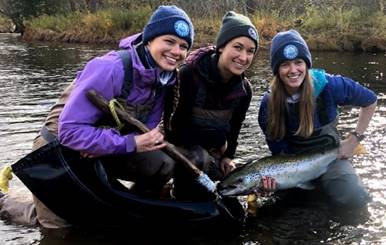

Project goal: This four-year project identifies threats and improves fish habitat for multiple aquatic species at risk through biological assessments, habitat restoration and stewardship outreach in participating Mi'kmaw communities. The Two-Eyed Seeing approach of this project will bring together Mi'kmaq Ecological Knowledge (MEK) and western science, allowing for a greater understanding of the role and importance of multiple perspectives.
The project takes place in three areas across mainland Nova Scotia: the St. Croix River, Stewiacke River and Southern Gulf of Saint Lawrence watersheds. This approach addresses high-priority threats to aquatic species at risk and to species of importance in Mi'kmaq culture for food, social and ceremonial purposes. Mi'kmaw community engagement, participation and species at risk stewardship are essential parts of this project and will ensure there is a lasting, positive impact in terms of conservation, increased awareness and capacity to protect species at risk for future generations.
Fund Allocation: $2,308,257
Time Frame: 4 years
Species that benefit from this project:
Habitat restoration along the Wolastoq
Habitat restoration along the Wolastoq
Recipient: Maliseet Nation Conservation Council
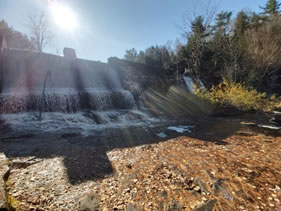

Project goal:This four-year project improves freshwater fish habitat within the Wolastoq (St. John River) watershed through the removal of barriers to fish passage and restoration of deteriorated habitat. Specific areas to be restored as part of this project will be selected based on priority, with preference given to known habitat of fish species at risk that are of significance to Wolastoqey (Maliseet) culture and livelihood.
Fund Allocation: $896,500
Time Frame: 4 years
Species that benefit from this project:
An integrated approach for the recovery of Nova Scotia Southern Upland Aquatic Species at Risk
An integrated approach for the recovery of Nova Scotia Southern Upland Aquatic Species at Risk
Recipient: Nova Scotia Salmon Association

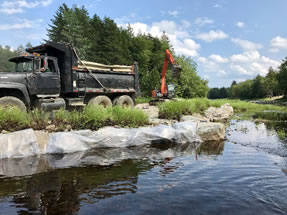
Project goal:This four-year project carries out activities in the Nova Scotia Southern Uplands priority area with three main objectives. The first is to establish integrated conservation planning for priority watersheds within the Southern Uplands area by developing detailed watershed recovery and stewardship plans that promote the recovery of eight priority watersheds supporting key species at risk.
The second objective of the project is to undertake acid rain mitigation, improve aquatic connectivity and restore fish habitat. To mitigate the impact of acid rain, this project uses helicopters to apply lime to forest soils within the catchment of an important tributary of the West River, Sheet Harbour, with the assistance of Nova Scotia Lands and Forestry.
The third objective of the project is to capitalize on opportunities to design and build, or purchase critical equipment that reduce the cost associated with future ongoing restoration, further benefitting future conservation actions.
Fund Allocation: $2,916,491
Time Frame: 4 years
Species that benefit from this project:
St. Croix River habitat connectivity alternatives for migratory fishes
St. Croix River habitat connectivity alternatives for migratory fishes
Recipient: Peskotomuhkati Nation at Skutik

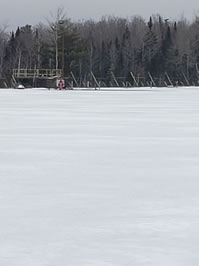
Project goal:The one-year project is focused on reconnecting the Skutik/St. Croix River and Passamaquoddy Bay ecosystems by identifying passage opportunities for at risk migratory fish species at two of the main stem dams. The project identifies fish passage issues at each site and recommends approaches to improve efficiency for passage, including fishway designs and flow requirements while considering site constraints and impacts on energy and existing infrastructure.
Restoring migratory fishes to these habitats will rebuild the critical cultural and economic relationship of the Passamaquoddy people to this unique river.
Fund Allocation: $140,000
Time Frame: 1 years
Species that benefit from this project:
Transforming our approach to species at risk: prioritizing and implementing actions for recovery in the Saint John River watershed
Transforming our approach to species at risk: prioritizing and implementing actions for recovery in the Saint John River watershed
Recipient: World Wildlife Fund (WWF) Canada
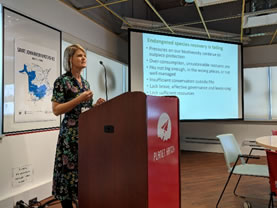
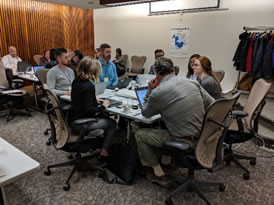
Project goal:This three-year project, taking place in the Saint John River watershed, (1) contributes to an increased understanding of at-risk species in the watershed; (2) identifies targeted priority actions to address threats to species at risk; and (3) implements priority recovery measures. In the long term, the project will contribute to improvements in the populations of at risk species, as well as proactive protection of aquatic species whose populations are not yet in decline, by protecting and enhancing freshwater habitat within the watershed.
This project utilizes a Priority Threat Management (PTM) approach to maximize the persistence of species at risk in the Saint John River watershed by determining the recovery actions with the greatest likelihood of success while effectively allocating resources. WWF Canada will complete the PTM assessment enabling the identification of recovery actions within the Saint John River watershed. Next, strategies will be developed in collaboration with partner organizations, to guide and implement the actions. Priority actions will have a lasting impact on the aquatic species of conservation concern in New Brunswick.
Fund Allocation: $746,320
Time Frame: 3 years
Species that benefit from this project:
- Date modified: